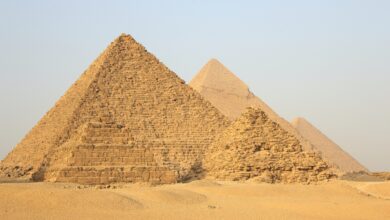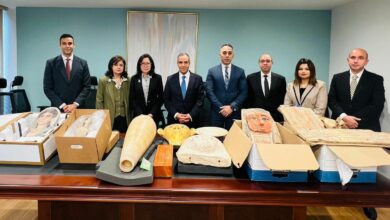Starting Friday, the renowned touring exhibition “Tutankhamun and the Golden Age of the Pharaohs” will make its final stop in New York City, 30 years after the boy king and his treasures had last visited the Big Apple, in 1979.
“Discovery Times Square Exposition”, a new exhibition space that opened last year, will host 130 artifacts that will be showcased until 2 January, 2011.
Part of this treasure collection was discovered in the young king’s funeral chamber while the rest was discovered in the Valley of the Kings.
Among the 5,000 precious and well-preserved artifacts discovered in the tomb, 50 burial objects have been selected by the board of the Cairo Museum to be part of the exhibition.
Included in the exhibition are Tut’s royal glass and diadem–inlaid with semi-precious stones–that was found on his head when the intact tomb was discovered by Howard Carter in 1922, as well as his cosmetic containers and one of the four gold coffinettes that contain his mummified organs.
The King’s golden chariot, never exhibited in the States before, was supposed be specially shipped to join this long series of exquisite artifacts showcased in New-York. However the airspace paralysis has blocked the chariot shipment for now. Dr Wafa el-Sadiq, the director of the Cairo Museum, explains that “we hope it can be shipped early next week but we cannot forecast when this impressive artifact will finally join the exhibition.”
Questioned about the overall cost of the shipment of “Tutankhamun and the Golden Age of the Pharaohs” exhibition, el-Sadiq says “several million dollars, but I am not sure of the exact amount. We’ve used the best shipping company and the cost is extravagant,” she adds.
The success of this touring exhibition is total. According to Allison Buchbinder, the press officer of the New York exhibiting space, “from the past seven cities where the exhibition toured, an average of one million people in each city saw the exhibition.” El-Sadiq is hoping for two million visitors, although she says they do not have an estimate number.
The frenzy which the exhibition is bound to cause has also a lot to do with the discoveries made public by Zahi Hawass, the secretary general of Egypt’s Supreme Council of Antiquities, last February around King Tut’s lineage and his cause of death.
“Two years ago the National Geographic Society sponsored CT-scans–X-ray machines that send several beams simultaneously–of King Tut’s mummified body,” explains Buchbinder. Those CT-scans shed new light on Tutankhamun’s death and have been used to create a unique replica of the mummy. “This mummy is absolutely true to life and will be exhibited for the very first time in New York,” she explains.
A new gallery has been added to the New York exhibition, exploring these latest discoveries from DNA testing that have revealed new details about the King’s family.
Dr Wafa el-Sadiq explains that a portion of the proceeds from the New York exhibition will be given to Egypt “to help antiquity conservation in Egypt and the building of the Grand Museum.”



